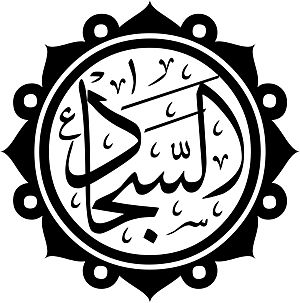Ali ibn Husayn facts for kids
Quick facts for kids
Ali ibn Husayn
|
|
|---|---|
 |
|
| Born | 659 |
| Died | 713 |
| Other names | Zayn al-Abidin, Imam as-Sajjad |
| Known for | Mysticism, Shia Imam |
|
Notable work
|
As-Sahifa as-Sajjadiyya, Al-Risalah al-Huquq, The fifteen munajat |
Ali ibn Husayn, also known as Zayn al-Abidin and Imam as-Sajjad, was a very important spiritual leader in Islam. He is considered the fourth Imam in Shia beliefs. An Imam is a leader who guides people in religious matters.
Ali ibn Husayn was the son of Husayn ibn Ali and the grandson of Ali ibn Abi Talib. He lived during a time of big changes and challenges for early Muslims. He is especially remembered for surviving a major historical event called the Battle of Karbala.
After the battle, he was taken to the caliph (the leader of the Muslim community at the time) in Damascus. Eventually, he was allowed to return to Medina, a holy city. His life was dedicated to teaching people about spirituality and religion. He shared his wisdom mostly through prayers and special requests to God. His most famous collection of prayers is known as As-Sahifa as-Sajjadiyya.
Contents
Who Was Ali ibn Husayn?
Ali ibn Husayn was born in the year 659. He was a direct descendant of the Islamic prophet Muhammad. His family was very respected in the early Muslim community. He grew up learning about Islam and its teachings.
He earned the titles Zayn al-Abidin, which means "Ornament of the Worshipers," and Imam as-Sajjad, meaning "The Constantly Prostrating One." These names show how devoted he was to prayer and worship.
Surviving a Big Battle
One of the most important events in Ali ibn Husayn's life was the Battle of Karbala in 680 CE. This battle was a major conflict that deeply affected the early Muslim community. Ali ibn Husayn was present at Karbala with his father, Husayn ibn Ali.
He was very ill during the battle, which prevented him from fighting. Because of his illness, he was one of the few male members of his family who survived the battle. This survival was seen as a miracle by many. After the battle, he and the other survivors were taken as captives to Damascus.
His Spiritual Teachings
After returning to Medina, Ali ibn Husayn spent his life teaching and guiding people. He focused on spiritual growth, morality, and understanding God. He believed in showing patience, kindness, and forgiveness, even to those who had wronged him.
He often taught through his prayers and supplications. These were not just personal prayers, but also ways to educate people about Islamic values and the importance of connecting with God. His teachings helped many people find peace and guidance during a difficult time.
Famous Writings
Ali ibn Husayn left behind several important works that are still studied today. These writings show his deep understanding of Islam and his strong spiritual connection.
- As-Sahifa as-Sajjadiyya: This is his most famous work. It is a collection of 54 prayers and supplications. These prayers cover many topics, like asking for forgiveness, thanking God, and seeking guidance. It's often called "The Psalms of the Household of Muhammad" because of its beautiful and meaningful language.
- Al-Risalah al-Huquq: This means "The Treatise on Rights." In this work, Ali ibn Husayn explains the rights that different people and things have over us. For example, it talks about the rights of God, your parents, your children, your neighbors, and even your body parts. It teaches people to be fair and responsible in all their relationships.
- The Fifteen Munajat: These are 15 intimate prayers where he speaks directly to God. They show his deep love and devotion.
Ali ibn Husayn passed away in 713 CE. He is remembered as a wise and patient leader who dedicated his life to spiritual guidance and teaching.
Images for kids
See also
 In Spanish: Ali ibn al-Husáyn para niños
In Spanish: Ali ibn al-Husáyn para niños


